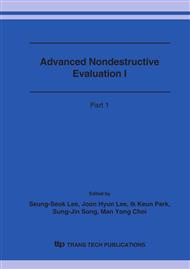p.603
p.607
p.611
p.615
p.620
p.624
p.628
p.632
p.636
The Effect of Cavity on the Creep Fracture in P92 and P122 Steels and Its Detection by Intelligent Phased Array Ultrasound
Abstract:
The results of cavity inspection in uniaxial creep tests and creep crack growth tests were compared to determine the cavity effect. The quantity of the cavities increased with increasing strain and crack growth rate as stress and temperature were increased. This resulted in the change of da/dt vs Ct. The increased rate in the number and size of the cavities in P92 steel with temperature was relatively fast, resulting in the high rate of da/dt against Ct. In this study, to determine the characteristics of defects in structure, the sub surface defects of P92 and P122 steels were investigated by an intelligent phased array ultrasonic inspection system. The system was found to be capable of detecting the creep crack length and the formation of cavities at the crack tip.
Info:
Periodical:
Pages:
620-623
Citation:
Online since:
October 2006
Authors:
Price:
Сopyright:
© 2006 Trans Tech Publications Ltd. All Rights Reserved
Share:
Citation:


